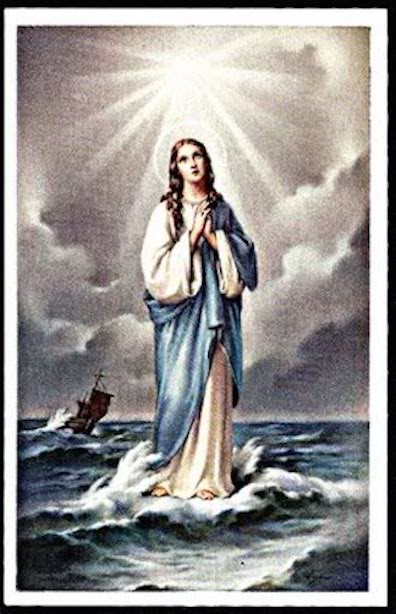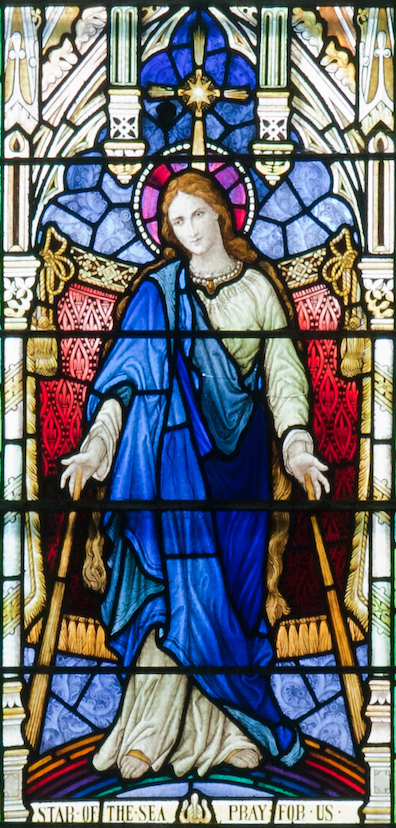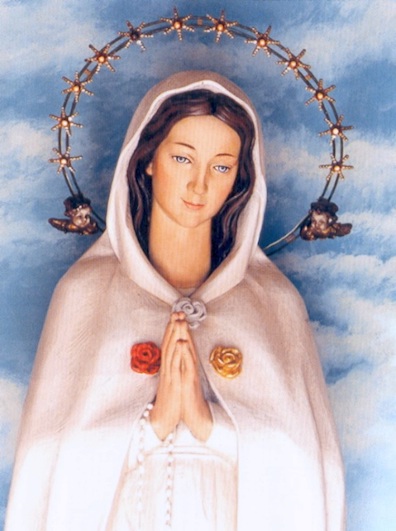The name Star of the Sea (Latin Stella Maris) is one
of many Catholic titles for Jesus's mother: Our Lady, Mother
of God, Blessed Virgin, Queen of Heaven, Mystical Rose, Most
Pure, the New Eve. It may have been inspired partly by a
passage in Revelation: "And there appeared a great wonder in
heaven; a woman clothed with the sun, and the moon under her
feet, and upon her head a crown of twelve stars" (12:1). After
obscure beginnings in the writings of Saint Jerome, Stella
Maris began to appear in ecclesiastical writings and
hymns of the 7th, 8th, and 9th centuries. At some point it
merged with seafarers' use of the same phrase for Polaris, the
unerring North Star of navigators. Sailors around the world
have long prayed to the Virgin Mary for deliverance from
storms, and many coastal churches around the world, like the one in Sandymount, have
been named Star of the Sea.
In Catholic devotions Mary is typically an intercessor
between sinners and God, and the nautical association has
inspired a metaphorical equivalent: the human heart is a
stormy sea and Mary a guiding light. In one of his 12th
century Marian homilies Saint Bernard of Clairvaux wrote, "If
the winds of temptation arise; if you are driven upon the
rocks of tribulation look to the star, call on Mary. If you
are tossed upon the waves of pride, of ambition, of envy, of
rivalry, look to the star, call on Mary. Should anger, or
avarice, or fleshly desire violently assail the frail vessel
of your soul, look at the star, call upon Mary." Joyce echoes
such language when the voices of men resisting alcoholic
temptation in the Sandymount church are said to pray "to her
who is in her pure radiance a beacon ever to the
stormtossed heart of man, Mary, star of the sea."
Marian devotions inevitably color sexual understandings of
women in Catholic countries. Joyce's Ireland was deeply
invested in the idea that unmarried women are either virgins
or whores. Stephen Dedalus's earliest glimmering of romantic
love, as a young boy in part 1 of A Portrait of the Artist
as a Young Man, comes in a Marian vision of the girl
next door: "Eileen had long thin cool white hands too because
she was a girl. They were like ivory; only soft. That was the
meaning of Tower of Ivory but protestants could not
understand it and made fun of it.... Her fair hair had
streamed out behind her like gold in the sun. Tower of
Ivory. House of Gold. By thinking of things you could
understand them." From this chastely spiritual beginning A
Portrait traces Stephen's descent into the dirty world
of sex workers, and back out. In part 5, as a university
student, he is still dreaming, albeit in what now seems a sexually charged way, of a woman
associated with "seraphim," "the smoke of praise," a
"eucharistic hymn," "sacrificing hands," and a "chalice."
Nausicaa takes this tension between sexual desire and
spiritual devotion to a new level of intensity, but now
thoughts of the Blessed Virgin inhabit the consciousness of a
young woman, herself as virginally naive as Stephen was before
visiting the Monto. Bloom's direction of carnal desire toward
this Virgin echoes in a most unorthodox way the worship taking
place in the church. One must note that Catholics strongly
object to the use of this word, "worship," in relation to
Mary: she is not a goddess, and so can receive only
"veneration" or "hyperdulia." They object in equal
measure to the word "mariolatry" (Mary + latria =
worship), a Protestant coinage that suggests idolatry. Joyce
did not hesitate to use either term, however. In a 3 January
1920 letter he described Nausicaa as "written in a
namby-pamby jammy marmalady drawersy (alto là!) style with
effects of incense, mariolatry, masturbation, stewed cockles,
painter's palette, chitchat, circumlocutions, etc., etc."
The incense and the painter's palette (in which shades of
blue predominate) hover around Gerty. Her hands are like
"finely veined alabaster" and her white face is "almost
spiritual in its ivorylike purity." Her eyes are "of the
bluest Irish blue," and in her carefully chosen palette of
sartorial colors blue is everywhere. She wears "A neat blouse
of electric blue" and a straw hat "trimmed with an underbrim
of eggblue chenille and at the side a butterfly bow to tone."
With four colors of undies to choose from, on this day she is
"wearing the blue for luck, hoping against hope, her own
colour and the lucky colour too for a bride to have a bit of
blue somewhere on her because the green she wore that day week
brought grief."
Thus iconographically defined as a Virgin, Gerty sits on the
seaside rocks listening to the men gathered "in that simple
fane beside the waves, after the storms of this weary
world, kneeling before the feet of the immaculate,
reciting the litany of Our Lady of Loreto, beseeching her to
intercede for them, the old familiar words, holy Mary, holy
virgin of virgins." From the church "the fragrant incense was
wafted and with it the fragrant names of her who was
conceived without stain of original sin, spiritual vessel,
pray for us, honourable vessel, pray for us, vessel of
singular devotion, pray for us, mystical rose. The
priest has told the men inside "what the great saint
Bernard said in his famous prayer of Mary, the most pious
Virgin's intercessory power that it was not recorded in
any age that those who implored her powerful protection were
ever abandoned by her." Gerty savors these devotional phrases
in memory, and she pictures the "scene in the church, the
stained glass windows lighted up, the candles, the flowers and
the blue banners of the blessed Virgin's sodality."
While she imagines these supplications to the Virgin in the
church, Bloom pays his devotions to the one nearest him. "His
dark eyes fixed themselves on her again drinking in her every
contour, literally worshipping at her shrine." Gerty
swings her legs in time to the hymns in the church and leans
far back, "and the garters were blue to match on account of
the transparent" and "he couldn't resist the sight of the
wondrous revealment half offered." Bloom's masturbation
makes him the storm-tossed supplicant, and Gerty plays her
corresponding role as the ever-tolerant, ever-indulgent Virgin
Mother and Mystical Rose. "Her woman's instinct told her that
she had raised the devil in him and at the thought a burning
scarlet swept from throat to brow till the lovely colour of
her face became a glorious rose." Although he has
profaned her sacred mystery, "there was an infinite store
of mercy in those eyes, for him too a word of pardon even
though he had erred and sinned and wandered. Should a
girl tell? No, a thousand times no. That was their secret,
only theirs."


